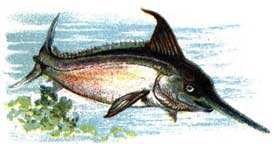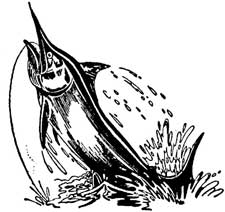|

The Gladiator: The swordfish is known as The Gladiator (gladius) because of the
sharp, sword-like bill it wields as a weapon—to spear prey
as well as for protection from its few natural predators. The mako
shark is one of the rare sea creatures big enough and fast enough
to chase down and kill an adult swordfish.

 Everywhere you look: Swordfish are distributed throughout the world's marine ecosystem,
in tropical, subtropical and temperate waters, between approximately
45° north and 45° south. They tend to concentrate where
major ocean currents meet, and along temperature fronts. They inhabit
the mixed surface waters where temperatures are greater than 15
°C but also can move and hunt in water as cool as 5 °C for
short periods aided by specially adapted heat exchange organs which
are able to increase the temperature of their brain and eyes by
10–15 °C. Everywhere you look: Swordfish are distributed throughout the world's marine ecosystem,
in tropical, subtropical and temperate waters, between approximately
45° north and 45° south. They tend to concentrate where
major ocean currents meet, and along temperature fronts. They inhabit
the mixed surface waters where temperatures are greater than 15
°C but also can move and hunt in water as cool as 5 °C for
short periods aided by specially adapted heat exchange organs which
are able to increase the temperature of their brain and eyes by
10–15 °C.
A Visit to the Islands: Areas of greater apparent abundance occur north of Hawaii along
the North Pacific transition zone, along the west coasts of the
U.S. and Mexico and in the western Pacific, east of Japan. Migration
patterns have not been described although tag release and recapture
data indicate an eastward movement from the central Pacific, north
of Hawaii, toward the U.S. West Coast. Acoustic tracking indicates
some diel movement from deeper depths during the daytime and moving
into the mixed surface water at night. At times they appear to follow
the deep scattering layer, and small prey, as they undertake these
vertical movements.
Matriarchs: Females grow larger than males, as males over 300 lb (135 kg) are
rare. Females mature at 4-5 years of age in northwest Pacific while
males mature first at about 3 to 4 years. In the North Pacific,
batch spawning occurs in water warmer than 24 °C from March
to July and year round in the equatorial Pacific. Adult swordfish
forage includes pelagic fish including small tuna, dorado, barracuda,
flying fish, mackerel, as well as benthic species of hake and rockfish.
Squid are important when available. Swordfish likely have few predators
as adults although juveniles are vulnerable to predation by large
pelagic fish.
Space Heaters: While swordfish are cold-blooded animals, they have special organs
next to their eyes to heat their eyes and also their brain. Temperatures
of 10 to 15 C° above the surrounding water temperature have
been measured. The heating of the eyes greatly improves the vision,
and subsequently improves their ability to catch prey. Out of the
25 000+ species of bony fish, only about 22 are known to have the
ability to heat selected body parts above the temperature of the
surrounding water. These include the swordfish, marlin, tuna and
some sharks.

 Deep Sea Divers: Swordfish have been observed spawning in the Atlantic Ocean, in
water less than 250 ft. (75 m) deep. Estimates vary considerably,
but females may carry from 1 million to 29 million eggs in their
gonads. Solitary males and females appear to pair up during the
spawning season. Spawning occurs year-round in the Caribbean Sea,
Gulf of Mexico, the Florida coast and other warm equatorial waters,
while it occurs in the spring and summer in cooler regions. Deep Sea Divers: Swordfish have been observed spawning in the Atlantic Ocean, in
water less than 250 ft. (75 m) deep. Estimates vary considerably,
but females may carry from 1 million to 29 million eggs in their
gonads. Solitary males and females appear to pair up during the
spawning season. Spawning occurs year-round in the Caribbean Sea,
Gulf of Mexico, the Florida coast and other warm equatorial waters,
while it occurs in the spring and summer in cooler regions.
Spawn: The most recognized spawning site is in the Mediterranean, off
the coast of Italy. The height of this well-known spawning season
is in July and August, when males are often observed chasing females.
The pelagic eggs are buoyant, measuring 1.6-1.8mm in diameter. Embryonic
development occurs during the 2 ½ days following fertilization.
As the only member of its family, the swordfish has unique-looking
larvae. The pelagic larvae are 4 mm long at hatching and live near
the surface. At this stage, body is only lightly pigmented. The
snout is relatively short and the body has many distinct, prickly
scales. With growth, the body narrows.
By the time the larvae reach half an inch long (12 mm), the bill
is notably elongate, but both the upper and lower portions are equal
in length. The dorsal fin runs the length of the body. As growth
continues, the upper portion of the bill grows proportionately faster
than the lower bill, eventually producing the characteristic prolonged
upper bill. Specimens up to approximately 9 inches (23 cm) in length
have a dorsal fin that extends the entire length of the body. With
further growth, the fin develops a single large lobe, followed by
a short portion that still reaches to the caudal peduncle. By approximately
20 inches (52 cm), the second dorsal fin has developed, and at approximately
60 inches (150 cm), only the large lobe remains of the first dorsal
fin.
All text is available under the terms
of the GNU Free Documentation License
|